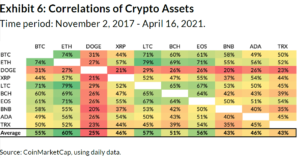The Future of Cryptocurrencies: Patterns to Enjoy in the Coming Years
The introduction of Central Bank Digital Currencies (CBDCs) stands to redefine the assimilation of electronic possessions within traditional monetary systems, while enhanced governing scrutiny may form the operational landscape for cryptocurrencies. Furthermore, the development of decentralized financing (DeFi) and the growing value of non-fungible tokens (NFTs) promise to change perceptions of possession and assessment in an electronic economy.
Rise of Reserve Bank Digital Currencies
The introduction of Central Bank Digital Currencies (CBDCs) stands for a significant change in the financial landscape as federal governments explore electronic choices to traditional fiat money. These state-backed electronic currencies aim to enhance the efficiency of settlement systems, advertise economic inclusion, and offer a secure option to personal cryptocurrencies. Unlike decentralized digital currencies, CBDCs run under the auspices of reserve banks, ensuring regulatory oversight and stability.
Several countries are proactively piloting or investigating CBDCs, with notable instances consisting of China's electronic yuan and the European Central Financial institution's electronic euro effort. These efforts highlight a growing recognition of the prospective advantages of electronic currencies, such as faster transaction speeds and lowered expenses related to cross-border settlements. Furthermore, CBDCs might work as a tool to fight illegal tasks by supplying better transparency in deals.
As the fostering of CBDCs proceeds, they might reshape consumer behavior and influence worldwide economic characteristics. However, the shift to a digital money framework provides difficulties, including technological infrastructure, cybersecurity issues, and public depend on. The increase of CBDCs represents a zero hour that could redefine the role of money in an increasingly electronic economic situation, necessitating close observation by sector stakeholders and policymakers alike.
Raised Regulative Examination

Countries globally are taking varied methods, from straight-out bans to regulative sandboxes that allow innovation while making certain compliance. The European Union, as an example, is moving towards detailed legislation with the Markets in copyright-Assets Regulation (MiCA), intended at creating a unified method across member states. In the United States, agencies like the SEC and CFTC are progressively active in providing guidelines and enforcement actions.
This governing environment is likely to have substantial implications for market participants. Business operating in the copyright area might face more stringent compliance needs, which could result in raised operational expenses. Nonetheless, clear laws can additionally cultivate greater institutional investment, as companies seek to navigate a more defined legal landscape. Eventually, the equilibrium in between innovation and regulation will form the future of cryptocurrencies.
Development of DeFi Platforms
Decentralized Finance (DeFi) platforms have undergone considerable transformation given that their creation, reshaping the traditional monetary landscape - order cryptocurrencies. Originally, these platforms mainly concentrated on basic functions such as borrowing and loaning, helped with by clever contracts on blockchain networks. original site Nevertheless, the advancement of DeFi has expanded to encompass a large array of monetary solutions, consisting of derivatives trading, yield farming, and automated market-making.
One of the most notable developments is the emergence of Layer 2 services, which boost scalability and reduce purchase prices, making DeFi a lot more easily accessible to a more comprehensive audience. Additionally, cross-chain interoperability has actually come to be a critical focus, allowing customers to transfer properties seamlessly throughout different blockchain networks. This advancement promotes better liquidity and user engagement.
Additionally, the combination of advanced administration models has equipped areas to join decision-making processes, advertising sustainability and innovation within the ecological community. As DeFi remains to mature, we can anticipate further improvements in customer experience via enhanced user interfaces and protection steps, addressing issues that have actually previously impeded mainstream adoption. On the whole, the trajectory of DeFi systems points towards Check Out Your URL a more inclusive and reliable financial future, providing choices to traditional financial systems.
Integration of NFTs in Money
In the middle of the quick advancement of the monetary landscape, the integration of Non-Fungible Tokens (NFTs) has actually become a transformative force. Generally associated with electronic art and collectibles, NFTs are currently locating applications in various economic industries, presenting innovative means to represent ownership and worth.
One considerable location of assimilation remains in actual estate, where NFTs can enhance home transactions. By tokenizing genuine estate possessions, purchasers can appreciate fractional possession, decreasing entry obstacles and raising liquidity. order cryptocurrencies. Furthermore, NFTs can guarantee clear and immutable records of possession, boosting count on in genuine estate ventures
In the globe of finance, NFTs are additionally being made use of for decentralized financing (DeFi) applications, enabling collateralization of assets. By using NFTs as security, customers can access financings while keeping ownership of their digital properties. This functionality enhances the accessibility of economic services and advertises a more inclusive monetary ecosystem.
Furthermore, the assimilation of NFTs into standard money might revolutionize the way intellectual residential property rights are handled, offering designers with brand-new revenue streams through smart More hints agreements. Generally, the integration of NFTs in financing represents a change in the direction of even more cutting-edge, reliable, and transparent economic services, leading the way for future advancements.
Developments in Blockchain Innovation

One substantial trend is the appearance of Layer 2 solutions, designed to improve scalability and transaction speeds, thus addressing the restrictions of primary blockchain networks. These solutions make it possible for quicker handling of transactions, decreasing charges and enhancing efficiency, which is essential for mass adoption.
Furthermore, interoperability in between different blockchain networks is acquiring traction. This development allows seamless information exchange and property transfers throughout varied platforms, promoting a much more linked and effective environment. Procedures that assist in cross-chain communication are important for fostering collaboration amongst decentralized applications (copyright) and boosting individual experiences.
Furthermore, developments in consensus devices, such as proof-of-stake and passed on proof-of-stake, are adding to more energy-efficient and safe and secure blockchain procedures. These advancements not only address ecological worries but also boost network strength.
As blockchain modern technology remains to mature, its assimilation right into various fields, consisting of finance, supply chain, and medical care, will certainly redefine standard systems, paving the means for a decentralized future.
Final Thought
The appearance of Central Bank Digital Currencies will certainly enhance the integration of electronic properties into conventional economic systems. In addition, the continual improvement of decentralized money platforms and blockchain technology, together with the assimilation of non-fungible symbols, will redefine ownership and economic transactions, promoting boosted fostering and technology within the sector.